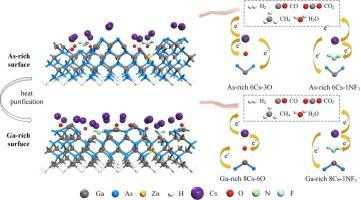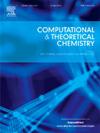富as和富ga GaAs(100)光电阴极表面对Cs-O和Cs-NF3吸附的优化研究
IF 3
3区 化学
Q3 CHEMISTRY, PHYSICAL
引用次数: 0
摘要
基于密度泛函理论,探讨了Cs-O和Cs-NF3在GaAs(100) β2(2 × 4)富as表面和β2(4 × 2)富ga表面的首选吸附位点和吸附比例。对于Cs-O的吸附,6cs - 30吸附富as表面的O吸附能最低,8cs - 60吸附富ga表面的功函数值最低。对于Cs-NF3的吸附,6Cs-1NF3构型在两个表面的功函数最小,过量的NF3使功函数增大,而8Cs-1NF3构型在富ga表面的NF3吸附能为负。残余气体增加了功函数,其中CO2吸附稳定,H2对功函数影响最小。值得注意的是,6cs - 30吸附的富as表面和8cs - 1nf3吸附的富ga表面具有较好的抗残余气体性能。电荷转移分析表明,表面Ga/As电荷依赖于重构和吸附比,Cs原子介导吸附物与表面之间的电荷再分配,影响偶极矩和功函数。这些发现提高了对GaAs光电阴极上最佳Cs-O和Cs-NF3激活构型的理解。本文章由计算机程序翻译,如有差异,请以英文原文为准。

Optimization of Cs-O and Cs-NF3 adsorption on As-rich and Ga-rich GaAs(100) photocathode surfaces: An ab-initio study
Based on density functional theory, the preferred adsorption sites and ratios of Cs-O and Cs-NF3 adsorption on GaAs(100) β2(2 × 4) As-rich surface and β2(4 × 2) Ga-rich surface were explored. For Cs-O adsorption, 6Cs-3O-adsorbed As-rich surface with lowest O adsorption energy and 8Cs-6O-adsorbed Ga-rich surface yield the lowest work function values. For Cs-NF3 adsorption, 6Cs-1NF3 configurations minimize the work function on both surfaces, excess NF3 increase work function, whereas 8Cs-1NF3 configuration on Ga-rich surface show the most negative NF3 adsorption energy. Residual gases increase work function, with CO2 adsorbing stably and H2 having minimal effect. Notably, 6Cs-3O-adsorbed As-rich surface and 8Cs-1NF3-adsorbed Ga-rich surface exhibit superior resistance to residual gases. Charge transfer analysis reveals that surface Ga/As charges depend on reconstruction and adsorbate ratios, Cs atoms mediate charge redistribution between adsorbates and the surface, influencing dipole moments and work function. These findings improve understanding of optimal Cs-O and Cs-NF3 activation configurations on GaAs photocathodes.
求助全文
通过发布文献求助,成功后即可免费获取论文全文。
去求助
来源期刊

Computational and Theoretical Chemistry
CHEMISTRY, PHYSICAL-
CiteScore
4.20
自引率
10.70%
发文量
331
审稿时长
31 days
期刊介绍:
Computational and Theoretical Chemistry publishes high quality, original reports of significance in computational and theoretical chemistry including those that deal with problems of structure, properties, energetics, weak interactions, reaction mechanisms, catalysis, and reaction rates involving atoms, molecules, clusters, surfaces, and bulk matter.
 求助内容:
求助内容: 应助结果提醒方式:
应助结果提醒方式:


